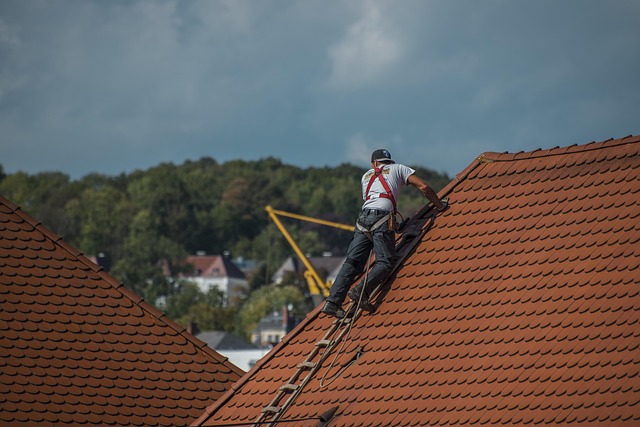Custom prefab roof designs prioritize insulation efficiency and ventilation for year-round comfort and structural integrity. High-performance insulators like fiberglass, cellulose, or foam boards trap air pockets for thermal protection, while adequate ventilation beneath the insulation prevents moisture buildup and reduces energy costs. Balancing insulation and ventilation through strategic design ensures optimal indoor air quality, temperature regulation, and long-term sustainability in custom prefab roof structures.
In the realm of modern construction, custom prefab roof designs offer unparalleled efficiency and versatility. However, ensuring proper insulation and ventilation is paramount for energy efficiency, moisture control, and long-lasting structure integrity. This article delves into the critical aspects of understanding specific insulation requirements for custom prefab roofs, highlighting the essential role of ventilation in achieving optimal performance. We explore best practices, material selection, and practical tips for balancing insulation and ventilation to maximize the benefits of these innovative building solutions.
Understanding Insulation Requirements for Custom Prefab Roof Designs
Custom prefab roof designs, while offering unparalleled efficiency and flexibility, require a nuanced understanding of insulation needs. The key lies in balancing energy efficiency with proper ventilation. Insulation is critical to maintain optimal indoor temperatures year-round, minimizing heat loss during winters and heat gain during summers.
For custom prefab roofs, material selection is paramount. High-performance insulants like fiberglass, cellulose, or foam boards can effectively trap air pockets, creating an insulating barrier against weather extremes. Additionally, ensuring adequate ventilation underneath the insulation prevents moisture build-up, which could compromise structural integrity and lead to costly repairs over time.
The Role of Ventilation in Energy Efficiency and Moisture Control
Proper ventilation is an integral part of any energy-efficient and comfortable living space, especially in prefab structures. By incorporating well-designed ventilation systems into custom prefab roof designs, manufacturers can significantly enhance the indoor air quality and overall performance of these buildings. Efficient ventilation helps regulate temperature, ensuring a consistent and comfortable climate throughout the year, which is crucial for reducing energy consumption and associated costs.
Moreover, adequate airflow plays a vital role in moisture control. Moisture buildup within walls and roofs can lead to condensation and even mold growth, causing structural damage and health issues. Ventilation allows excess humidity to escape, maintaining optimal moisture levels. This is particularly important in regions with high humidity or during seasons when indoor activities generate significant moisture, such as cooking, showering, and cleaning. Custom prefab roof designs that prioritize ventilation can thus contribute to a healthier and more sustainable living environment.
Best Practices for Achieving Optimal Insulation in Prefab Structures
To achieve optimal insulation in prefab structures, start by selecting high-performance insulation materials suited for your specific climate and building design. Custom prefab roof designs should incorporate R-values that meet or exceed industry standards, ensuring efficient heat retention during colder months and temperature regulation during warmer periods. Consider using lightweight yet durable insulators like cellulose, foam, or fiberglass to maintain structural integrity without adding excessive weight.
Best practices also involve seamless installation techniques, minimizing air gaps and ensuring proper sealing around windows, doors, and other penetrations. Employing specialized insulation contractors who are familiar with prefab construction methods can significantly enhance overall efficiency. Additionally, regular maintenance checks should be conducted to inspect for any signs of damage or deterioration, promptly addressing issues to maintain the structural integrity and energy efficiency of your custom prefab roof designs.
Choosing the Right Materials for Long-Lasting Performance
When designing or selecting a prefabricated structure, especially for custom prefab roof designs, choosing the right insulation materials is paramount to ensure long-lasting performance and energy efficiency. Opting for high-quality, durable insulants such as fibre glass, foam, or even natural materials like sheep’s wool can significantly enhance a building’s R-value, thereby reducing heat transfer and maintaining consistent indoor temperatures. This not only lowers energy costs but also prolongs the structural integrity of the prefab components against extreme weather conditions.
Ventilation systems play an equally crucial role in custom prefab roof designs. Proper ventilation helps regulate humidity levels, prevents the buildup of condensation, and reduces the risk of mould or mildew formation. Efficient ventilation systems also contribute to improved air quality indoors by facilitating a constant flow of fresh air, which is particularly important for occupant health and comfort. Integrating advanced ventilation technologies like mechanical or passive systems can significantly enhance the overall performance and longevity of the prefab structure.
Balancing Insulation and Ventilation: Tips for Efficient Design Implementation
In the pursuit of energy-efficient and comfortable living spaces, balancing insulation and ventilation is a delicate act in prefab design. While adequate insulation is crucial for temperature regulation, proper ventilation is essential to maintain indoor air quality. Custom prefab roof designs offer an opportunity to integrate advanced insulation materials while strategically placing vents and openings.
To achieve this balance, designers can employ clever tactics such as incorporating high-R value insulation, using reflective materials for added heat retention or protection against moisture, and positioning exhaust vents in areas that promote cross-ventilation. Additionally, carefully designed roof structures with integrated solar panels can contribute to passive cooling while harnessing renewable energy.
Proper insulation and ventilation are paramount in custom prefab roof designs to ensure energy efficiency, prevent moisture issues, and prolong structural integrity. By understanding specific requirements, leveraging best practices, and selecting suitable materials, designers can create sustainable and comfortable living spaces. Balancing insulation and ventilation is a delicate dance, but with thoughtful implementation, these strategies become the cornerstone of any successful prefab construction project.
